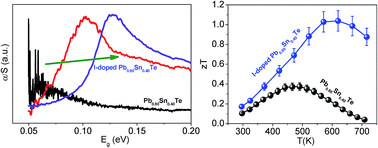Enhanced thermoelectric performance in topological crystalline insulator n-type Pb0.6Sn0.4Te by simultaneous tuning of the band gap and chemical potential†
Abstract
Tailoring the electronic structure of topological crystalline insulators (TCIs) is necessary to enhance their thermoelectric (TE) performance. p-Type chemical doping in a TCI such as Pb0.6Sn0.4Te exhibited a significantly high TE figure of merit (zT), but the n-type Pb0.6Sn0.4Te is still elusive and is urgently needed for thermoelectric applications. Herein, we report enhanced thermoelectric performance in n-type iodine (I) doped Pb0.6Sn0.4Te. Aliovalent I− doping in the Te2− sublattice of Pb0.6Sn0.4Te widens the band gap via breaking of local crystal mirror symmetry, which decreases the bipolar conduction and pushes the Seebeck maxima towards high temperatures. Iodine doping in Pb0.6Sn0.4Te significantly increases the n-type carrier concentration and shifts the chemical potential (Fermi level) inside the conduction band of Pb0.6Sn0.4Te, thus improving the electrical transport properties. We report a maximum zT of 1.05 in the n-type Pb0.60Sn0.40Te0.995I0.005 sample at 620 K, which is 483% higher than pristine Pb0.6Sn0.4Te.



 Please wait while we load your content...
Please wait while we load your content...